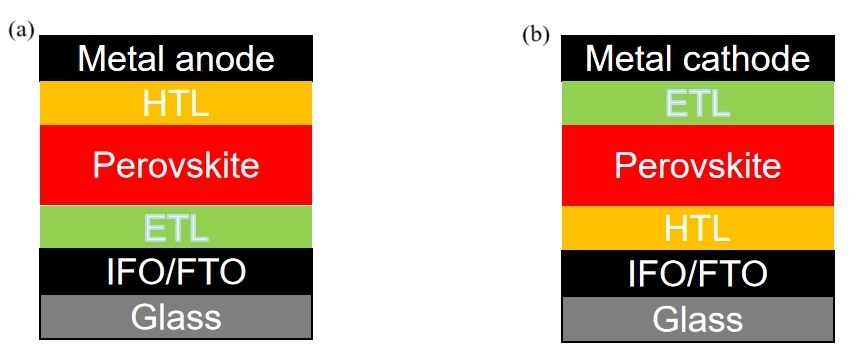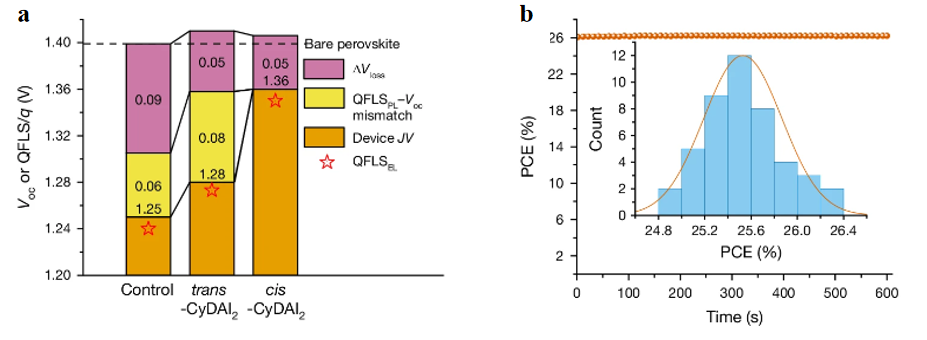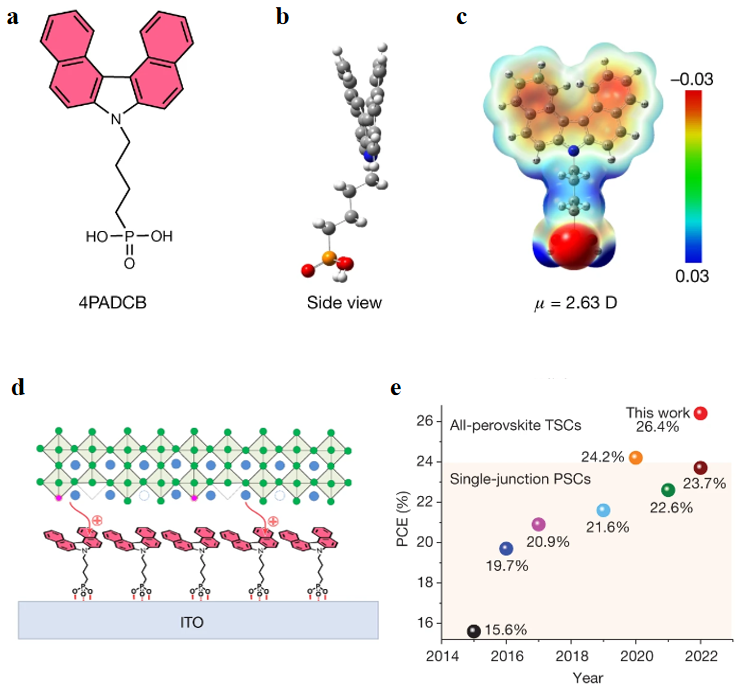1. Introduction
Perovskite solar cells (PSCs) have garnered extensive interest in the photovoltaic community due to their remarkable power conversion efficiency (PCE), cost-effective production methods, and compatibility with diverse, low-temperature fabrication processes. These attributes make PSCs strong contenders in the race for next-generation solar technologies. In recent years, the power conversion efficiency of all-perovskite tandem cells has impressively exceeded 28.4% [1], underscoring the rapid pace of innovation in this domain. As technology matures, PSCs have demonstrated not only outstanding potential in laboratory-scale research but also growing viability for commercial and large-scale applications. Among the structural configurations developed for PSCs, the regular n-i-p (NIP) architecture stands out as one of the earliest and most studied designs (Figure 1a). This configuration features a well-established and reproducible fabrication process, coupled with high energy conversion efficiency, making it a foundational model in PSC research [2]. However, the NIP architecture is not without its limitations. One of the most critical challenges is the inherent sensitivity of perovskite materials to environmental factors, particularly moisture. Exposure to humid conditions leads to rapid material degradation, compromising long-term stability and device performance [3]. Additionally, the fabrication of high-performance NIP PSCs often requires high temperature annealing to produce high-quality electron transport layers (ETLs). This not only increases energy consumption and production costs but also restricts the use of flexible or temperature-sensitive substrates, thereby limiting the scalability and application scenarios for this type of device [4]. To mitigate these challenges, the inverted p-i-n (PIN) architecture has emerged as a compelling alternative (Figure 1b). In this design, the sequence of functional layers is reversed: the ETL is deposited beneath the perovskite absorber, while the hole transport layer (HTL) is positioned above. This rearrangement offers multiple advantages. First, it enables low-temperature processing, eliminating the need for high-temperature annealing and thereby reducing energy input and broadening the range of compatible substrate materials [5]. Second, the PIN architecture enhances environmental stability, particularly under humid and thermal stress. By optimizing the interfacial contact between adjacent layers, PIN-type PSCs also reduce charge carrier recombination losses, which contributes to improved device performance and operational durability [6]. Although substantial progress has been made in enhancing the efficiency and stability of PIN-structured PSCs, there remains significant scope for further performance optimization through material innovation and interface engineering.
Beyond structural improvements in single-junction devices, the pursuit of even higher efficiencies has directed research efforts toward tandem perovskite solar cells. These advanced architectures aim to overcome the theoretical and practical limitations of single-junction PSCs by incorporating multiple absorber layers with complementary bandgaps. The tandem configuration broadens the spectral absorption range, enabling more effective use of the solar spectrum and paving the way for higher theoretical power conversion limits [7]. Tandem PSCs are generally classified into two main types: series-connected (monolithic) tandems and parallel-connected tandems. In the series-connected configuration, multiple sub-cells are vertically stacked and electrically connected in the series. Each sub-cell is tailored to absorb a specific segment of the solar spectrum, thereby maximizing the total photon-to-electron conversion efficiency [8]. On the other hand, parallel-connected tandem architectures link the sub-cells electrically in parallel. While this configuration typically results in slightly lower efficiencies compared to monolithic tandems, it offers notable benefits such as simplified fabrication processes and improved tolerance to current mismatch, which in turn enhances operational stability under variable lighting conditions [9]. Overall, the development of tandem perovskite solar cells represents a transformative step forward in photovoltaic technology. By leveraging the synergistic properties of perovskite materials with different bandgaps, tandem devices promise superior energy harvesting capabilities, elevated conversion efficiencies, and improved environmental robustness. These attributes not only solidify tandem PSCs as a key area of research but also point to a viable pathway for future commercial solar energy solutions.

Figure 1: Schematic diagrams of perovskite solar cell structures: (a) Planar regular (n-i-p) architecture, (b) Planar inverted (p-i-n) architecture
2. Development of perovskite solar cells
Perovskite solar photovoltaic (PV) cells have undergone a remarkable evolution since their initial introduction. At the time of their first report, the power conversion efficiency (PCE) of these devices was a mere 3.8% [10]. This relatively low efficiency limited their early competitiveness with established photovoltaic technologies. However, within just a few years, rapid advancements in materials science, device engineering, and fabrication techniques led to dramatic improvements in efficiency. This unprecedented rate of progress has positioned perovskite solar cells (PSCs) as one of the most promising technologies for next-generation solar energy applications. In the early stages of development, PSCs predominantly employed a regular structure known as the n-i-p configuration. In this architecture, the solar cell is constructed by sequentially depositing an electron transport layer (ETL), a perovskite light-absorbing layer, and a hole transport layer (HTL) onto a transparent conductive substrate. While this design proved effective in achieving relatively high initial efficiencies, it also presented several intrinsic limitations. Most notably, the regular structure is prone to the formation of interfacial defects that hinder charge transport and facilitate non-radiative recombination. Furthermore, the n-i-p architecture is particularly sensitive to environmental conditions such as humidity and temperature fluctuations, which negatively impact device stability and lifespan. To address these drawbacks, researchers proposed an alternative structural approach: the inverted p-i-n configuration. This design reverses the order of the charge transport layers by first depositing the HTL, followed by the perovskite absorber, and finally the ETL. The inverted architecture offers several compelling advantages. It significantly reduces the density of interfacial defects, thereby enhancing charge extraction and reducing recombination losses. Moreover, this configuration exhibits improved tolerance to environmental stressors and allows for lower-temperature processing, which is conducive to flexible and lightweight substrates. As a result, the inverted structure has become a pivotal strategy for advancing both the efficiency and the long-term operational stability of PSCs. Building on these architectural innovations, the development of tandem perovskite solar cells marks a significant leap forward in the field. Tandem configurations typically integrate multiple light-absorbing layers with different bandgaps to capture a broader range of the solar spectrum. This approach enables higher theoretical efficiencies than single-junction cells, as it minimizes thermalization and transmission losses. Additionally, tandem PSCs offer improved thermal stability and lower overall energy losses, thanks to optimized energy-level alignment and more effective charge separation. These advantages not only enhance device performance but also expand the range of potential applications—from rooftop installations to portable and integrated solar technologies. In summary, the continuous evolution from regular to inverted, and eventually to tandem architecture, highlights the dynamic progress in perovskite solar cell research. Each structural innovation builds upon the limitations of its predecessor, contributing to the realization of high-efficiency, stable, and scalable photovoltaic solutions. As tandem PSCs gain traction, they represent a critical milestone toward the commercialization of perovskite-based solar energy systems and their integration into the global renewable energy landscape [11].
3. Operating characteristics of tandem perovskite solar cell structures
Tandem perovskite solar cells represent a significant advancement in photovoltaic technology by strategically combining materials with different bandgap energies to capture a broader portion of the solar spectrum. This multi-junction architecture allows for improved solar energy utilization and enhanced power conversion efficiency (PCE) compared to single-junction devices. Fundamentally, tandem configurations operate on the principle of spectral matching, in which two or more sub-cells are vertically stacked in a sequence based on descending bandgap values. In a typical two-terminal tandem cell, a wide-bandgap perovskite layer serves as the top cell, absorbing high-energy, short-wavelength photons. Meanwhile, the remaining lower-energy, longer-wavelength photons are transmitted through the top layer and absorbed by a bottom cell—often a narrow-bandgap silicon or perovskite material. This complementary absorption mechanism reduces energy losses associated with thermalization and incomplete absorption, thereby maximizing solar energy conversion and improving overall efficiency and thermal stability of the device [12]. Despite these advantages, tandem perovskite solar cells, particularly those employing wide-bandgap perovskite materials—face several performance-related challenges. One of the key limitations is the relatively large voltage loss often observed in wide-bandgap perovskites, which results from an increased mismatch between the quasi-Fermi level splitting and the open-circuit voltage. This voltage deficit can constrain the performance ceiling of tandem architectures and hinder their efficiency potential [13]. To address this, researchers have explored interfacial passivation techniques and molecular engineering strategies aimed at minimizing recombination and enhancing charge carrier dynamics. For example, Jiang X. introduced a passivation method using cis-cyclohexane-1,4-diammonium diiodide (CyDAI₂), which effectively reduced interfacial non-radiative recombination and improved the energetic alignment between the perovskite absorber and adjacent transport layers [14]. This treatment not only improved the open-circuit voltage but also increased the bandgap of the perovskite layer to 1.36 V (Figure 2a). When this top cell was paired with an organic bottom cell featuring a 1.27 eV bandgap, the resulting tandem structure achieved a significant enhancement in overall PCE (Figure 2b), illustrating the importance of bandgap tuning and interface optimization.

Figure 2: (a) Relationship between quasi-Fermi level splitting and open-circuit voltage for various film structures, used to evaluate voltage loss. (b) Distribution of PCE values for perovskite-organic tandem solar cells [1]
In addition to material engineering, the performance of tandem PSCs is heavily influenced by device-level considerations such as optical management, current matching, and interfacial engineering. One particularly effective strategy involves the incorporation of anti-reflection coatings and advanced light-management structures to minimize reflection losses and increase photon harvesting. Furthermore, precise power and current matching between the sub-cells is essential in two-terminal tandem devices, as any mismatch can lead to efficiency bottlenecks. To this end, Dewei Z. and colleagues employed a phosphonic acid-based self-assembled monolayer, 4PADCB, to improve interfacial energy level alignment within wide-bandgap perovskite top cells [15]. This molecular interface modification reduced charge recombination at critical interfaces, improved light absorption indirectly through enhanced charge extraction, and facilitated the creation of a tandem configuration composed of a 1.8 eV top cell and a 1.2 eV bottom cell. The synergy between the optimized interfaces and tailored bandgap pairing contributed to an extended absorption spectrum and enabled the device to achieve excellent power conversion efficiency. In summary, the successful operation of tandem perovskite solar cells relies on a multifaceted interplay of material properties, interfacial chemistry, optical engineering, and device architecture. Continuous efforts in passivation, bandgap tuning, and structural optimization are essential to overcoming voltage losses and achieving commercially viable efficiencies. As research progresses, tandem architecture is expected to play a pivotal role in defining the future of high-performance, stable, and scalable photovoltaic technologies.

Figure 3: (a) Molecular structure of 4PADCB, (b) Side view of 4PADCB, (c) Electrostatic potential of 4PADCB, (d) Schematic of interconnections among ITO, HTL, and PVSK via 4PADCB, (e) PCE of a tandem cell consisting of a 1.8 eV top cell and a 1.2 eV bottom cell [15]
4. Conclusion
This paper summarizes the significant progress in power conversion efficiency achieved by tandem perovskite solar cells. Despite these advancements, key challenges persist. The inherent sensitivity of perovskite materials to humidity, light exposure, and thermal stress continues to restrict their long-term operational stability. Future research efforts must prioritize enhancing the environmental resilience of perovskite materials through advanced material engineering. Concurrently, developing scalable fabrication methods is critical, with a focus on improving film uniformity and minimizing defects for large-scale production. For tandem cell optimization, exploring high-performance interlayer materials and adopting rational device architectures will be essential to maximize light absorption and charge collection efficiency. In conclusion, tandem perovskite solar cells stand as a highly promising photovoltaic technology. Their sustained progress demands collaborative efforts across disciplines—including materials science, device engineering, and manufacturing technology. By systematically addressing current limitations, tandem perovskite solar cells are poised to become a cornerstone of next-generation high-efficiency solar energy systems.
References
[1]. Mishima,R.et al. Luminescence coupling in 28.4%-efficient tandem solar cell utilizing 20.8%-efficient perovskite minimodule stacked on silicon cell. AIP Publishing,123, 263510 (2023)
[2]. Ge, Y., Zheng, L., Wang, H. et al. Suppressing wide-angle light loss and non-radiative recombination for efficient perovskite solar cells. Nat. Photon. 19, 170–177 (2025).
[3]. Zhou,X,et al.Role of moisture in the preparation for efficient planar perovskite solar cells.ACS Sustainable Chem. Eng. 7, 17691–17696 (2019).
[4]. Wu, S., Li, C., Lien, S. Y., & Gao, P. (2024). The temperature issue: Enhancing the performance and stability of perovskite solar cells through advanced annealing approaches. Chemistry, 6, 207–236.
[5]. Tan,H.et al.Efficient and stable solution-processed planar perovskite solar cells via contact passivation. Science, 355, 722-726(2017).
[6]. Huanping Zhou et al. ,Interface engineering of highly efficient perovskite solar cells.Science345,542-546(2014)
[7]. Yi Hou et al. ,Efficient tandem solar cells with solution-processed perovskite on textured crystalline silicon.Science367,1135-1140(2020).
[8]. Amran Al-Ashouri et al. ,Monolithic perovskite/silicon tandem solar cell with >29% efficiency by enhanced hole extraction.Science370,1300-1309(2020).
[9]. García Cerrillo, J., Distler, A., Matteocci,F., et al Matching the Photocurrent of 2-Terminal Mechanically-Stacked Perovskite/Organic Tandem Solar Modules by Varying the Cell Width. Sol. RRL, 8: 2300767.(2024)
[10]. Journal of the American Chemical Society,J. Am. Chem. Soc. 2009, 131, 17, 6050–605
[11]. Zeng, L., Tang, L., Luo, Z., Gong, J., Li, J. and Xiao, X. (2024), A Review of Perovskite/Copper Indium Gallium Selenide Tandem Solar Cells. Sol. RRL, 8: 2301059.
[12]. Alan R. Bowman, Felix Lang, Yu-Hsien Chiang, et al.. Stranks, Relaxed Current Matching Requirements in Highly Luminescent Perovskite Tandem Solar Cells and Their Fundamental Efficiency Limits. ACS Energy Letters 2021 6 (2), 612-620
[13]. Brinkmann, K. O. et al. Perovskite-organic tandem solar cells with indium oxide interconnect. Nature 604, 280–286 (2022)
[14]. Jiang, X., Qin, S., Meng, L. et al. Isomeric diammonium passivation for perovskite–organic tandem solar cells. Nature 635, 860–866 (2024)
[15]. He, R., Wang, W., Yi, Z. et al. Improving interface quality for 1-cm2 all-perovskite tandem solar cells. Nature 618, 80–86 (2023)
Cite this article
Zheng,K. (2025). A Study on the Development Status of Tandem Perovskite Solar Cells. Applied and Computational Engineering,162,21-26.
Data availability
The datasets used and/or analyzed during the current study will be available from the authors upon reasonable request.
Disclaimer/Publisher's Note
The statements, opinions and data contained in all publications are solely those of the individual author(s) and contributor(s) and not of EWA Publishing and/or the editor(s). EWA Publishing and/or the editor(s) disclaim responsibility for any injury to people or property resulting from any ideas, methods, instructions or products referred to in the content.
About volume
Volume title: Proceedings of CONF-FMCE 2025 Symposium: Semantic Communication for Media Compression and Transmission
© 2024 by the author(s). Licensee EWA Publishing, Oxford, UK. This article is an open access article distributed under the terms and
conditions of the Creative Commons Attribution (CC BY) license. Authors who
publish this series agree to the following terms:
1. Authors retain copyright and grant the series right of first publication with the work simultaneously licensed under a Creative Commons
Attribution License that allows others to share the work with an acknowledgment of the work's authorship and initial publication in this
series.
2. Authors are able to enter into separate, additional contractual arrangements for the non-exclusive distribution of the series's published
version of the work (e.g., post it to an institutional repository or publish it in a book), with an acknowledgment of its initial
publication in this series.
3. Authors are permitted and encouraged to post their work online (e.g., in institutional repositories or on their website) prior to and
during the submission process, as it can lead to productive exchanges, as well as earlier and greater citation of published work (See
Open access policy for details).
References
[1]. Mishima,R.et al. Luminescence coupling in 28.4%-efficient tandem solar cell utilizing 20.8%-efficient perovskite minimodule stacked on silicon cell. AIP Publishing,123, 263510 (2023)
[2]. Ge, Y., Zheng, L., Wang, H. et al. Suppressing wide-angle light loss and non-radiative recombination for efficient perovskite solar cells. Nat. Photon. 19, 170–177 (2025).
[3]. Zhou,X,et al.Role of moisture in the preparation for efficient planar perovskite solar cells.ACS Sustainable Chem. Eng. 7, 17691–17696 (2019).
[4]. Wu, S., Li, C., Lien, S. Y., & Gao, P. (2024). The temperature issue: Enhancing the performance and stability of perovskite solar cells through advanced annealing approaches. Chemistry, 6, 207–236.
[5]. Tan,H.et al.Efficient and stable solution-processed planar perovskite solar cells via contact passivation. Science, 355, 722-726(2017).
[6]. Huanping Zhou et al. ,Interface engineering of highly efficient perovskite solar cells.Science345,542-546(2014)
[7]. Yi Hou et al. ,Efficient tandem solar cells with solution-processed perovskite on textured crystalline silicon.Science367,1135-1140(2020).
[8]. Amran Al-Ashouri et al. ,Monolithic perovskite/silicon tandem solar cell with >29% efficiency by enhanced hole extraction.Science370,1300-1309(2020).
[9]. García Cerrillo, J., Distler, A., Matteocci,F., et al Matching the Photocurrent of 2-Terminal Mechanically-Stacked Perovskite/Organic Tandem Solar Modules by Varying the Cell Width. Sol. RRL, 8: 2300767.(2024)
[10]. Journal of the American Chemical Society,J. Am. Chem. Soc. 2009, 131, 17, 6050–605
[11]. Zeng, L., Tang, L., Luo, Z., Gong, J., Li, J. and Xiao, X. (2024), A Review of Perovskite/Copper Indium Gallium Selenide Tandem Solar Cells. Sol. RRL, 8: 2301059.
[12]. Alan R. Bowman, Felix Lang, Yu-Hsien Chiang, et al.. Stranks, Relaxed Current Matching Requirements in Highly Luminescent Perovskite Tandem Solar Cells and Their Fundamental Efficiency Limits. ACS Energy Letters 2021 6 (2), 612-620
[13]. Brinkmann, K. O. et al. Perovskite-organic tandem solar cells with indium oxide interconnect. Nature 604, 280–286 (2022)
[14]. Jiang, X., Qin, S., Meng, L. et al. Isomeric diammonium passivation for perovskite–organic tandem solar cells. Nature 635, 860–866 (2024)
[15]. He, R., Wang, W., Yi, Z. et al. Improving interface quality for 1-cm2 all-perovskite tandem solar cells. Nature 618, 80–86 (2023)









